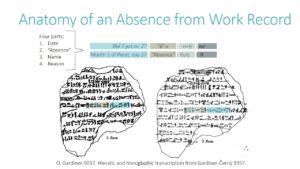Numerous ostraca recording daily absences were recovered at Deir el-Medina. These not only inform us about work practices at the site, but also tell us about health and social roles in village life. As part of my research on Deir el-Medina, I compiled a database with over 2,000 absences and 70 separate texts. The chart below illustrates how many of these sources only provide a handful of absences, while others account for a large percentage of the total absences recorded.
These absences are also distributed unevenly between the 19th and 20th dynasties. The 19th dynasty was a more successfully bureaucratic period at Deir el-Medina, and consequently contains more recorded absences than the 20th dynasty.
Ostraca from and around Deir el-Medina come in varying degrees of completeness. In some lucky cases, texts can be extensive documenting around 300 absences over the span of several months. In others, a text may just be a quick note or so broken that we can only glean one or two words from it.
Workmen gave a variety of reasons for their absences. Look at the list below to learn more about the detailed information we can glean from these valuable texts.
To learn more about these fascinating texts and ways we can use them to understand illness at Deir el-Medina, check out my article:
Austin, Anne. “Accounting for sick days: A scalar approach to health and disease at Deir el-Medina.” Journal of Near Eastern Studies 74.1 (2015): 75-85.

